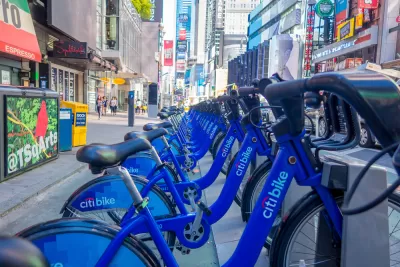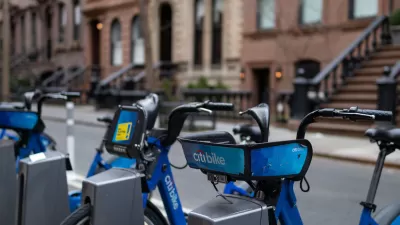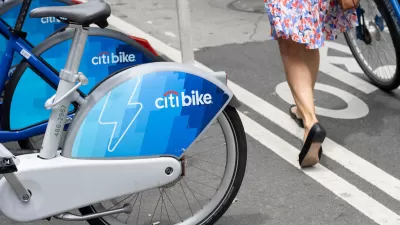The popular NYC bike share system will likely survive the company’s current financial setbacks, but other, smaller bike share systems may not be so lucky.

What does trouble at the company operating four of the top five bike share systems in the United States mean for shared bike systems and, more specifically, for New York City’s Citi Bike? Alissa Walker asks this question in Curbed, assessing how Lyft’s recent financial woes could impact U.S. bike share systems operated by the ride-hailing giant.
Walker describes the company’s history with bike share, starting with its acquisition of Motivate in 2018. “Lyft originally positioned its foray into bike share as part of building the ultimate multimodal-transportation app, bundling its ride-hailing services with bike or e-scooter rental or the ability to buy transit tickets.”
Now, with its financial future in peril, Lyft has killed some of its bike share systems altogether and increased prices in others. According to Walker, cities are once again looking at forming their own municipally owned bike share systems—a more common feature pre-Bird and Lyft—to limit the volatility and maintain service.
Walker predicts that “Even if Lyft starts making bike-share cuts in the name of cost savings, it’s unlikely New York City will see the same fate as Minneapolis,” where Lyft abruptly ended service last month. “Citi Bike — which has seen a 33 percent year-over-year increase in ridership so far in 2023 — also has the model that’s preferred by Lyft: an exclusive, multiyear, public-private partnership that Lyft says justifies infrastructural improvements and service expansions.” But the future may not be as bright for smaller cities who can’t afford the same level of commitment and funding.
FULL STORY: What Does the Potential Demise of Lyft Mean for Citi Bike?

Alabama: Trump Terminates Settlements for Black Communities Harmed By Raw Sewage
Trump deemed the landmark civil rights agreement “illegal DEI and environmental justice policy.”

Planetizen Federal Action Tracker
A weekly monitor of how Trump’s orders and actions are impacting planners and planning in America.

The 120 Year Old Tiny Home Villages That Sheltered San Francisco’s Earthquake Refugees
More than a century ago, San Francisco mobilized to house thousands of residents displaced by the 1906 earthquake. Could their strategy offer a model for the present?

In Both Crashes and Crime, Public Transportation is Far Safer than Driving
Contrary to popular assumptions, public transportation has far lower crash and crime rates than automobile travel. For safer communities, improve and encourage transit travel.

Report: Zoning Reforms Should Complement Nashville’s Ambitious Transit Plan
Without reform, restrictive zoning codes will limit the impact of the city’s planned transit expansion and could exclude some of the residents who depend on transit the most.

Judge Orders Release of Frozen IRA, IIJA Funding
The decision is a victory for environmental groups who charged that freezing funds for critical infrastructure and disaster response programs caused “real and irreparable harm” to communities.
Urban Design for Planners 1: Software Tools
This six-course series explores essential urban design concepts using open source software and equips planners with the tools they need to participate fully in the urban design process.
Planning for Universal Design
Learn the tools for implementing Universal Design in planning regulations.
Clanton & Associates, Inc.
Jessamine County Fiscal Court
Institute for Housing and Urban Development Studies (IHS)
City of Grandview
Harvard GSD Executive Education
Toledo-Lucas County Plan Commissions
Salt Lake City
NYU Wagner Graduate School of Public Service





























